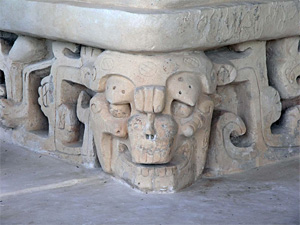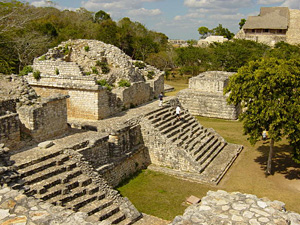True Yucatan Treasure Sat Hidden for 12 Centuries
 Eliot Kleinberg - Cox News Service Eliot Kleinberg - Cox News Service
go to original


| | Stucco platform base facade at Ek Balam. | 
| | Ek Balam (dogmatic) |
Ek Balam, Mexico – Black swollen clouds slid across the sky. Ahead of us loomed 55 stone steps, treacherously steep and slick with the whipping rain.

Our guide, Carlos, didn't ask, "Do you want to do this?" He motioned, palm up, and said, "Let's go."

So we went.

Lightning cracked the sky, jolting us in our ascent. Seconds later, thunder rumbled across the plains of the Yucatan.

A wind suddenly whipped up and chilled the air.

The rain gods roared, desperate to send us fleeing in terror. But we clambered on, crabbing to the top on all fours.

One last frightening step around an edge, and we were at the tomb of Ukit-Kan Lek.

For centuries, the largest building in Ek Balam – Mayan for "black jaguar" – lay partially hidden, its 146-metre-long, 29-metre-high walls peeking up from a snarl of thick vines and brush.

Archaeologists knew it as far back as the late 1800s. But in 1997, explorers chipping away at the wall stood slack-jawed at what they saw – and what we now saw.

Looming in front of us: a 4.2-metre-high fresco, approximating the giant wide-open mouth of a jungle cat.

Along the bottom "jaw" are 30-centimetre-high stucco teeth. Above the mouth is a headless figure. At the eyes are the figures of two gods who hold up the world.

On each side of the face, two guards stand watch. Surrounding the head: nine life-size jaguar heads, plus a series of figures.

A tarp now covers the gaping maw. A decade ago, the explorers walked through the mouth. Behind it, they found the 1,200-year-old body of Ukit-Kan Lek, the Snake Gourd King.

Surrounding him were 4,800 pieces of jade.

How the man and his priceless trove, now in museums, remained hidden from banditos for 12 centuries is perhaps the greatest mystery of all.

But the most amazing aspect is the incredibly pristine condition of the soft and vulnerable stucco, protected all those years by the outside wall – even as its counterparts in Chichen Itza and Tulum have been decimated by the forces of sun, water and wind.

"They may be the finest stuccoes preserved in the ancient Maya world," said Clifford T. Brown, assistant professor of anthropology at Florida Atlantic University, who worked at Ek Balam as a graduate student from 1986 to '89.

Our guide, Carlos, said there's been talk of building a visitor centre at Ek Balam. The country's National Institute of Anthropology and History is studying the option.

But the Mexican government appears in no hurry to see it go the way of Chichen Itza, with its roadside hawkers, giant visitor centre, turnstiles, gift shops and a latte stand.

Ek Balam has only a tiny parking lot. |



